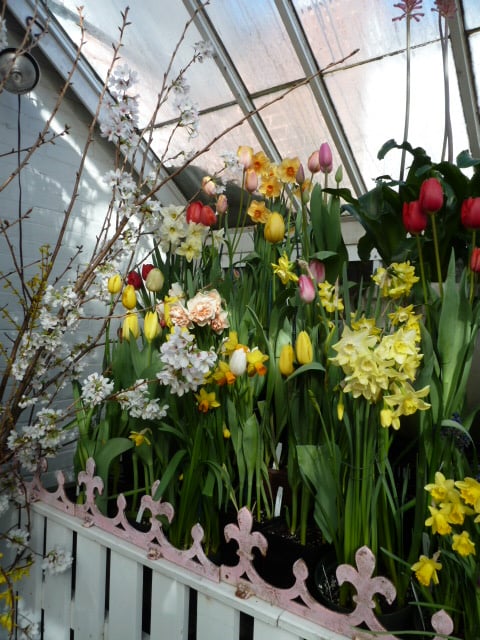
As part of an annual tradition at Smith College, in Northampton, Massachusetts, rooted ivy cuttings are distributed to each incoming first year student–just one indicator of the botanic leanings of this prestigious women’s college. With late winter’s days lengthening, Smith’s Lyman Conservatory– one of the few remaining plant conservatories in the United States built in the nineteenth century–is clearly the heart of campus. And for residents of the surrounding valley, Smith’s Spring Bulb Show—a campus tradition for the last one hundred years– is as sure a sign of the coming thaw as its annual Chrysanthemum Show is a harbinger of summer’s close. Rob Nicholson, the Conservatory’s Manager, has been the man behind both these impressive horticultural events for the past twenty-two years.
This year’s theme, “In the Pink,” featured a center island in the first greenhouse, anchored by a fanciful pavilion and two resplendent pink wheelbarrows, festooned with spring blooms in shades from pastel to shocking pink. Although they’re gloriously represented, this wasn’t just about tulips and daffodils—subtle pink Veltheimia buds, and bright pink azaleas added complexity to breathtaking masses of bulbs, which included hyacinths, scilla, and ipheion.
Miniature pink bird houses—created by botany students– added grace notes above a pink iron fleur de lis fence –once roof-trim for the greenhouse. The second greenhouse featured deeper non-pink hues. Forced branches of witch hazel, plums and forsythia filled the air with fragrance. Rob says the biggest challenge is coordinating the wide variety of hardy and non-hardy bulbs so they bloom for the same two-week period– requiring a highly detailed forcing schedule. He points out that work-study students help arrange the show every year, and estimates that over 25,000 visitors attend it.

Students of Victorian history are familiar with that period’s fondness for dressing small boys in feminine clothes, but who knew that until World War II, pink was popularly considered a boy’s color, and blue was for girls? Like lilac and rose, pink is a color that derives its name from a plant. Dianthus, in the carnation family, were called “pinks” because of their frilly, “pinked” edges; they were also often shades of pink.
Considering the abundance of pink-toned tulips, daffodils and hyacinths in this display, visitors might conclude that the color pink is common among these plants in nature. But pink tulips are actually rare, and pink narcissus and hyacinth never occur in the wild. Human intervention and manipulation—also known as plant-breeding– has made them possible. Just as inspired human effort can result in the appearance of spring within a glass house, while winter remains outdoors.










